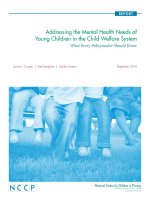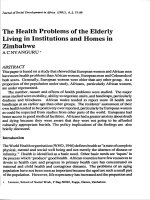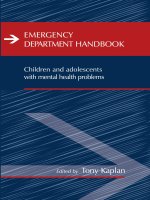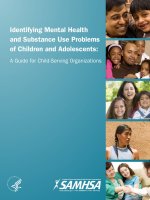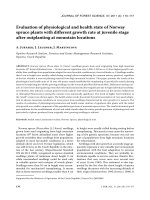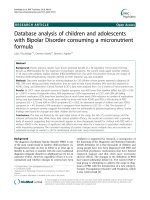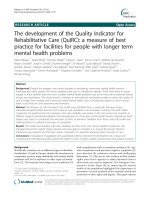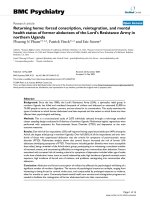Mental health problems of children and adolescents, with and without migration background, living in Vienna, Austria
Bạn đang xem bản rút gọn của tài liệu. Xem và tải ngay bản đầy đủ của tài liệu tại đây (850.89 KB, 9 trang )
Gutmann et al.
Child Adolesc Psychiatry Ment Health
(2019) 13:35
/>
RESEARCH ARTICLE
Child and Adolescent Psychiatry
and Mental Health
Open Access
Mental health problems of children
and adolescents, with and without migration
background, living in Vienna, Austria
Maria Teresa Gutmann1†, Metin Aysel2†, Zeliha Özlü‑Erkilic3, Christian Popow4 and Türkan Akkaya‑Kalayci3*
Abstract
Background: Compared to their indigenous peers, migrant children and adolescents are at increased risk for mental
health problems. The aim of our study was to compare psychological disorders of children and adolescents with Turk‑
ish migration background and their native Austrian peers.
Methods: We analysed 302 children and adolescents aged between 7 and 18 years. The sample consisted of 100
Austrian and 100 Turkish outpatients with mental health problems, and 102 healthy controls, 52 with Austrian and 50
with Turkish background, recruited from various Viennese local child and youth centres.
Results: Native patients had more frequently externalizing problems (42.1%) compared to the Turkish-speaking sam‑
ple (28%). However, in the control group, Turkish-speaking children and adolescents had higher levels of internalizing,
depressive and anxiety symptoms compared to their native peers.
Conclusions: We found noticeable differences in psychological problems among children and adolescents with and
without migration background. We assume that migration-related stress factors are responsible for these differences.
Also, children and adolescents with migration background seek for psychological help less frequently than their indig‑
enous peers.
Keywords: Mental health, Psychological disorders, Turkish-speaking migrants, Children, Adolescents, Migration
background
Background
Worldwide, approximately 20% of children and adolescents are affected by mental health problems [1] with an
increasing number of chronic mental health problems
[2]. Stressful life events (death of a closely related person,
parental divorce, serious illness etc.) chronic stress, e.g.
due to school problems, conflicts with family members or
peers, may be in the background of these mental health
problems [3].
*Correspondence: tuerkan.akkaya‑
†
Maria Teresa Gutmann and Metin Aysel contributed equally to this paper
3
Outpatient Clinic of Transcultural Psychiatry and Migration‑Induced
Disorders in Childhood and Adolescence, Department of Child
and Adolescent Psychiatry, Medical University of Vienna, Währinger Gürtel
18‑20, 1090 Vienna, Austria
Full list of author information is available at the end of the article
Gao et al. [5] observed that mental health problems
increased bimodally with age: with a minor peak between
ages 6 and 10 years, and a major peak between ages 13
and 16 years. These age-related frequencies are not
directly related to specific mental disorders [4]. Internalizing and externalizing problems as well as behavioural
problems are more frequently observed in adolescents
than in younger children [5, 6]. Major depression, e.g. is
more frequently observed in adolescents than in children
[7]. More boys than girls suffer from externalizing problems in their childhood [8], whereas more girls than boys
undergo mental health problems during adolescence [4,
7, 9].
Boys generally are more likely to present behavioural
[10] and externalizing problems [5, 11, 12], whereas,
internalizing problems is more commonly observed in
girls [12]. Girls usually present higher levels of anxiety
© The Author(s) 2019. This article is distributed under the terms of the Creative Commons Attribution 4.0 International License
(http://creativecommons.org/licenses/by/4.0/), which permits unrestricted use, distribution, and reproduction in any medium,
provided you give appropriate credit to the original author(s) and the source, provide a link to the Creative Commons license,
and indicate if changes were made. The Creative Commons Public Domain Dedication waiver ( />publicdomain/zero/1.0/) applies to the data made available in this article, unless otherwise stated.
Gutmann et al. Child Adolesc Psychiatry Ment Health
(2019) 13:35
[13–15], phobias [16] and depression. In addition, anxiety disorders are highly comorbid with depressive disorders [17].
A large number of studies confirm migration as a
high-risk factor for mental health problems [18–20].
Migration-related stress, economic disadvantages, and
discrimination increase the vulnerability of the persons
concerned [21–24].
Turkish-speaking migrants living in Austria have been
reported to suffer more likely from poverty and mental
disorders compared to the indigenous population [25, 26]
and to more frequently present symptoms such as anxiety, nervousness, discomfort and severe fatigue [27].
Migrants and especially females with migration background face more challenges and are therefore particularly more vulnerable to mental health problems [28,
29]. In addition to being more vulnerable to loss of family members, migrant children and adolescents are more
exposed to acts of discrimination, racism and xenophobia [25, 30–35]. Consequently the physical [36] and mental health [34, 37, 38] of migrant children and adolescents
are more endangered compared to their native peers.
The study of Diler et al. reported higher levels of
depression and anxiety among migrant children and
adolescents compared to their indigenous peers [39, 40].
Migrant adolescents score higher on the CBCL scales
[41]: withdrawn, anxiety/depression, social problems,
attention deficit, and internalizing problems [6]. Children
having a low socioeconomic background face more mental health and internalizing problems [10] because they
are exposed to high levels of social stress [4, 16, 42].
Shoshani et al. [43] showed that especially older and
female adolescents with migration background present
more mental health problems than their native peers.
Brettschneider et al. [44] found that adolescents with
migration background and especially female adolescents
with Turkish migration background had more severe
mental health problems than their native German peers.
About 10.4% of the European population are migrants
[45]. The fertility rate among migrants living in European countries is quite high; consequently, the number
of children and adolescents with migration background
is steadily growing [46, 47]. Regardless of the fact that
18.9% of the Austrian population had a migration background in 2012 [48] research focusing on mental health
problems of migrants is scarce [49].
Providing a specialized outpatient service for migrant
children and adolescents with mental health problems,
we prospectively investigated children and adolescents
with psychosocial problems and with or without Turkish migration background, and a group of healthy control children. The aim of the study was to analyse the
transcultural background of mental health problems.
Page 2 of 9
We hypothesized that mental health problems would
be higher in children and adolescents with Turkish
migration background and that these children would
have more internalizing, externalizing, and behavioural
problems, as well as increased levels of depression and
anxiety.
Methods
We prospectively investigated 200 children and adolescents aged between 7 and 18 years attending our outpatient service because of mental health problems. In the
clinical sample 100 native and 100 Turkish-speaking
patients were involved. A control sample of healthy, similar-aged children consisted of 50 Turkish and 52 Austrian
children. They were recruited from various Austrian and
Turkish child and youth centres in Vienna.
The gender distribution was quite similar in Turkish
speaking and Austrian participants (F (1, 294) = 0.04,
p = 0.84) and study groups (F (1, 294) = 0.09, p = 0.76).
The gender distribution was different in the whole study
sample (F (1, 294) = 4.34, p = 0.04), female patients were
older (M = 12.11, SD = 0.26) than the males (M = 11.33,
SD = 0.26).
We used six standard questionnaires for assessing
psychopathology:
1. YSR/11-18 (Youth Self Report for minors aged
between 11 and 18 years) [50], in order to assess the
internalization and externalization problems.
2. CBCL/4-18 (Child Behavior Checklist for minors
aged between 4 and 18 years) [51], in order to assess
the internalization and externalization problems.
Additionally Turkish version of CBCL was used [52].
3. SES (Self-Esteem Scale) [53], in order to assess the
self-esteem.
4. DIKJ (Inventory for Depression of children and adolescents) [54], in order to assess depression.
5. STAI-K (Inventory for anxiety of children and adolescents aged between 7 and 14 years) [55], in order to
assess anxiety.
6. STAI (Inventory for anxiety of adolescents aged
between 15 and 18 years) [56], in order to assess anxiety.
The Ethics Committee of the Medical University of
Vienna approved this study. We obtained informed consent from all children and adolescents and from their
parents before including them in the study.
Statistical analysis
For the present study, the statistical analysis was conducted with IBM SPSS Statistics 21.0. We calculated descriptive parameters, and used ANOVA and
Gutmann et al. Child Adolesc Psychiatry Ment Health
(2019) 13:35
MANOVA for analysing differences in parametric data.
The “Chi-Quadrat-Tests” and “Fisher´s exact tests” were
used for non-parametric data, assuming significant differences at an alpha level ≤ 0.05.
Results
Study sample
302 children participated in the study: 152 were native
Austrians, and 150 were children and adolescents with
a Turkish migration background. The mean age of the
whole study sample was 11.7 ± 3.1 (SD) years. The clinical
group consisted of 200 patients, the control group of 102
subjects. These groups were divided according to their
age in two groups, 7–11 years and 12–18 years (Table 1).
Psychiatric diagnosis according to the ICD‑10 classification
Table 2 lists the clinical diagnoses of the clinical groups
and their sex distribution.
Analysing differences in the distribution of diagnoses
among children and adolescents with and without migration background, we observed significant differences for
gender (Fisher’s Exact Test = 17.20, p = 0.01) and migration background (Fisher’s Exact Test = 18.38, p < 0.01).
The clinical and control groups differed particularly
Table 1 Study sample
Austrian
participants
Female
Turkish speaking
participants
Male
Female
Total
Page 3 of 9
in their distribution of the F9 diagnoses. F9 diagnoses
were more frequently observed in males (44.4%) than in
females (25.8%), and more frequently in Austrian children (42.1%) than in the Turkish-speaking sample (28%).
F8 diagnoses were observed only in the Turkish-speaking
sample. Age dependency was observed only as a tendency (Fisher’s Exact Test = 11.84, p = 0.06; Table 2).
Internalizing and externalizing problems as assessed
by the parents (CBCL/4‑18)
Internalizing problems
The mean internalizing problems scale score was by
12.97 (SD = 9.61).
Significantly more (F (1, 286) = 7.36, p = 0.01) children and adolescents with Turkish migration background scored higher on the internalizing problems scale
(M = 12.66) than the Austrian children (M = 9.94).
Comparing the clinical and control groups, we found
significant differences between both these groups but
not between the two clinical groups (Table 3). Children
of the control group with a Turkish migration background (M = 8.71) compared to Austrian control children
(M = 3.48) showed higher mean scores.
We found no significant gender differences for internalizing problems between the two study groups.
Table 3 Internalizing problems (mean ± SD) of Austrian
and Turkish-speaking children
Internalizing problems
Male
Austrian
participants
Turkish
speaking
participants
Clinical group
16.40
SD = 0.82
16.61
SD = 0.82
Control group
3.48
SD = 1.14
8.71
SD = 1.17
Clinical group
7–11 years
25
25
22
25
97
12–18 years
25
25
28
25
103
13
14
14
13
54
Control group
7–11 years
12–18 years
Total
12
13
12
11
48
75
77
76
74
302
Nationality
Study group
Table 2 Frequencies and percentages of psychiatric diagnosis depending on nationality and gender
Nationality
Austrian participants
F3 (mood (affective) disorder
F4 (neurotic, stress-related and somatoform disorders)
Sex
Turkish speaking
participants
Female
Male
7 (4.6%)
9 (6%)
11 (7.3%)
5 (3.3%)
18 (11.8%)
27 (18%)
27 (17.9%)
18 (11.9%)
F5 (behavioural syndromes associated with physiological
disturbances and physical factors)
2 (1.3%)
1 (0.7%)
2 (1.3%)
1 (0.7%)
F6 (disorders of adult personality and behaviour)
9 (5.9%)
11 (7.3%)
15 (9.9%)
5 (3.3%)
F8 (disorders of psychological development)
0 (0%)
10 (6.7%)
6 (4%)
F9 (behavioural and emotional disorders with onset usually
occurring in childhood and adolescence)
64 (42.1%)
42 (28%)
39 (25.8%)
4 (2.6%)
67 (44.4%)
Gutmann et al. Child Adolesc Psychiatry Ment Health
(2019) 13:35
Page 4 of 9
Externalizing problems
Behavioural problems as assessed by parents
The mean externalizing problems scale score was 13.95
(SD = 12.47).
Significantly more (F (1, 286) = 11.14, p < 0.01) native
patients scored higher on the externalizing problems
scale (M
=
20.92) than the Turkish-speaking patients
(M = 15.53).
In the clinical group, the Austrian patients (M = 20.92)
scored higher on the externalizing problems than the
Turkish patients (M = 7.11) and the control groups did.
Turkish-speaking patients (M = 15.53) had significantly
more externalizing problems than native (M = 4.01) and
Turkish speaking (M = 7.11) children and adolescents of
the control groups (Table 4).
We found significant gender differences for externalizing problems (F (1, 146) = 4.84, p = 0.03). Significantly
more males (M = 14.88) than females (M = 12.00) had
externalizing problems.
The clinical group presented significantly (F (1,
286) =
157.77, p
<
0.01) more behavioural problems
(M = 55.33) than the control group (M = 18.37).
The multivariate analysis showed significant differences
for behavioural problems between nationality and study
group (F (1, 286) = 11.33, p < 0.01; Turkey’s HSD = 10.11).
The univariate analysis showed that, native children
and adolescents (M
=
11.70) had significantly lower
scores in behavioural problems than their Turkish-speaking (M = 25.03) peers as well as Austrian (M = 58.57) and
Turkish-speaking (M = 52.09) patients (Table 5).
Furthermore, Austrian and Turkish-speaking minors in
the clinical groups showed significantly higher scores for
behavioural problems compared to the control groups.
We found no significant gender differences for behavioural problems between the two study groups.
Internalizing and externalizing problems as assessed
by the children themselves (YSR)
The mean score of internalizing problems was 15.34
(SD = 9.45) and the mean score of externalizing problems
was 14.33 (SD = 8.05). The multivariate analysis showed
significant differences for gender (F (2, 145)
= 3.22,
p = 0.04) and study group (F (2, 145) = 9.44, p < 0.01).
The influence of the migration background was not
significant (F (2, 145) = 2.62, p = 0.08). The univariate
analysis showed that males reported significantly more
externalizing problems than females (M
= 14.88 vs.
M = 12.00, F (1, 146) = 4.84, p = 0.03).
The univariate analysis showed significant effects for
both scales of internalizing (F (1, 146) = 7.18, p = 0.01)
and externalizing problems (F (1, 146) = 16.89, p < 0.01).
The clinical sample reported significantly more internalizing (M = 16.67) and externalizing (M = 16.13) problems
than the controls (internalizing problems: M = 12.41,
F = 7.18, p =
0.01; externalizing problems: M
= 10.74,
F = 16.89. p < 0.01).
We found significant differences for depression between
the two study groups (F (1, 286) = 30.61, p < 0.01) and
between the two age groups (F (1, 286) = 5.24, p = 0.02).
The clinical sample (M = 14.36) had higher depression
scores than the control sample (M = 9.38). Furthermore,
depression was significantly more frequent among older
children and adolescents (M = 12.89) in comparison to
the younger (M = 10.84) sample.
We observed significant interactions between depression score and migration background (F (1, 286) = 4.01,
p = 0.05; Turkey’s HSD = 3.08).
Austrian (M = 14.61) and Turkish-speaking (M = 14.10)
clinical samples had higher mean depression scores than
both control groups. Whereas children of the control
group with a Turkish migration background (M = 10.93)
compared to Austrian control children (M
= 7.83)
exhibited significantly higher mean depression scores
(Table 6).
We found no significant gender differences for depression between the two study groups.
Table 4 Externalizing problems (mean ± SD) of Austrian
and Turkish-speaking children
Table
5 CBCL/4-18 behavioural problems (mean
± SD)
of Austrian and Turkish-speaking children
Externalizing problems
Behavioural problems
Nationality
Austrian
participants
Turkishspeaking
participants
Clinical group
20.92
SD = 1.04
15.53
SD = 1.05
Control group
4.01
SD = 1.45
7.11
SD = 1.48
Study group
Depression
Nationality
Austrian
participants
Turkishspeaking
participants
Clinical group
58.57
SD = 2.41
52.09
SD = 2.42
Control group
11.70
SD = 3.35
25.03
SD = 3.43
Study group
Gutmann et al. Child Adolesc Psychiatry Ment Health
(2019) 13:35
Table 6 Depression (mean ± SD) of Austrian and Turkishspeaking children
Depression
Nationality
Austrian participants
Turkishspeaking
participants
Clinical group
14.61
SD = 0.74
14.10
SD = 0.74
Control group
7.83
SD = 1.02
10.93
SD = 1.05
Study group
Anxiety
The multivariate analysis showed significant differences for anxiety between nationality (F (2, 285) = 3.63,
p = 0.03), the study groups (F (2, 285) = 5.64, p < 0.01) and
age groups (F (2, 285) = 5.82, p < 0.01). The group with a
Turkish migration background (M
= 51.21) presented
higher state-anxiety scores than the Austrian group
(M = 48.13).
The univariate analysis showed that Austrian subjects
(M = 44.40), females (M = 45.95) and the younger group
(M = 44.02) of the control sample had lower state-anxiety
scores in comparison to the other groups (Table 7).
Discussion
Our results showed noticeable differences for mental
health problems among children and adolescents with
and without migration background.
Internalizing, externalizing, and behavioural problems
Both, parental CBCL and self-assessed YSR scores were
higher for internalizing and externalizing problems compared to the respective control groups.
Janssen et al. [6] reported higher behavioural problem
scores for internalizing problems among youths with
Turkish migration background when compared to Dutch
peers. Our results support these findings. We speculate that Turkish-speaking minors are more exposed
Page 5 of 9
to external problems like migration-related stress, and
maybe do not seek adequate professional help in time. In
addition, migrant children tend to hide their problems in
order not to appear feeble.
Austrian psychiatric patients exhibited higher scores
for externalizing problems than their Turkish-speaking
peers. Gao et al. [5] found in a Chinese sample, that children with migration background had more internalizing and externalizing mental health problems compared
to their native peers. This difference may probably be
explained by population-based differences in education
standards and the related social behaviour.
Darwish Murad et al. [57] reported results that did not
differ from our analyses. Turkish speaking adolescents
reported more problem behaviour such as internalising
problems than their Dutch peers. This ethnic difference
between adolescents with and without migration background, may also be due to divergences in their socioeconomic status [57].
ICD‑10 psychiatric diagnoses
The psychiatric diagnoses F8 (disorders of psychological development) were present only among Turkishspeaking patients. Whereas, the psychiatric disorder, F9
(behavioural and emotional disorders with onset usually
occurring in childhood and adolescence) were diagnosed
more frequently among native patients compared to the
Turkish-speaking sample.
Akkaya-Kalayci et al., Ceri et al. and Webb et al. [24, 25,
31] also reported that specific psychiatric diagnoses were
more commonly observed among migrants compared to
the indigenous population. The difference may also be
explained by population-based differences. On the other
hand, ADHD may have a civilizing background.
Depression
In accord with previous studies [54, 58], children and
adolescents in our study had higher depression scores
compared with children and adolescents of the control
sample. Similar to studies [7, 9, 16, 59], we found no
Table 7 Anxiety (mean ± SD) of the nationality, gender and age groups
State-anxiety
Nationality
Gender
Age
Austrian
participants
Turkish- speaking
participants
Female
Male
Age between 7
and 11
Age
between 12
and 18
Clinical group
51.86
SD = 0.93
50.55
SD = 0.93
51.59
SD = 0.93
50.81
SD = 0.93
51.35
SD = 0.94
51.06
SD = 0.91
Control group
44.40
SD = 1.28
51.59
SD = 1.31
45.95
SD = 1.29
50.04
SD = 1.30
44.02
SD = 1.26
51.97
SD = 1.34
Study group
Gutmann et al. Child Adolesc Psychiatry Ment Health
(2019) 13:35
gender or age-related differences in our study sample but
an age-dependent increase of depression symptoms.
Children of the Austrian control sample exhibited
lower depression scores when compared to the Turkish
control subjects and the Austrian and Turkish patients.
In line with our results, higher prevalences of depression [6, 60] and anxiety [31, 61, 62] have been reported
among migrant populations. The higher depression
scores may be interpreted as migration-stress related
even in the 2nd and 3rd generations (LIT).
Anxiety
Anxiety scores were elevated in both clinical groups, with
no age or gender-related differences. Age and genderrelated differences were only seen in the control groups.
Moreover, Austrian and Turkish-speaking control groups
differed in their anxiety levels. Turkish-speaking children and adolescents in our study and control groups had
similar anxiety levels (Table 7). These results are partly in
line with the study of Brunner [58].
Anxiety levels usually increase with age, particularly
during adolescence [16, 17, 63, 64]. We only found such
differences in the control groups, where females and
younger children exhibited lower anxiety scores. Usually,
anxiety scores are lower in boys [13, 14, 63, 65].
Migrant children and adolescents, similar to migrant
adults, were described to have higher overall anxiety
scores compared to autochthonous children [39, 66–68].
The study of Borgna and Contini [69] report, that children and adolescents with migration background are
disadvantaged in the school system, as most of the features of the educational system do not cover the needs
of migrant children. The differences in our study may be
related to the specific situation of the Turkish-speaking
children in the school system.
Our findings show that non-clinical Turkish-speaking
children and adolescents had higher levels of internalizing, depressive and anxiety symptoms, which probably
are in relation to migration-induced acculturation stress
that impaired their mental health. Since the migrant population does not adequately and timely use mental health
services, they only ask for professional help when severe
problems occur [70].
These results can also be explained with cross-cultural
differences among native Austrians and Turkish speaking
migrants, especially in the cultural dimensions of individualism and collectivism. Austrians are individualistically
oriented, in contrary the Turkish community is collectively oriented which makes their lifestyles quite different
in many aspects [71]. Among individualistically oriented
societies, members see themselves as autonomous
agents, therefore their own preferences and goals have
priority. In contrary, in collectivist societies, a strong
Page 6 of 9
connection among members of the social group is present and loyalty is quite important, so that they choose
goals, which do not threaten group harmony [72]. Turkish families living in Austria are mostly very traditionally
and hierarchically oriented. As the majority of the Turkish population is collectively oriented and also belongs to
Islamic faith, Turkish speaking children probably suffer
from acculturation stress in Austria because of the larger
cultural and religious differences between the culture of
origin and the dominant host culture [25, 73–75].
Furthermore, in the present study we analysed factors
like socio-economic status or acculturation stress, which
may be related to transcultural differences. Our results
showed that children and adolescents with Turkish
migration background had a lower socio-economic status compared to their indigenous peers; additionally they
were impaired due to a high level of acculturative stress.
Conclusions
Chronic mental health problems of children and adolescents increase steadily and exert a growing burden on the
health-care system that suffers from increasing utilization. Therefore, preventive measures, aimed at reducing
mental health problems become more and more important [76].
Migration-related illness promoting factors like acculturation stress, discrimination, racist and xenophobic
politics, and economic disadvantage especially affect vulnerable children [30, 31, 35, 77–83].
Migrants, due to many reasons, use mental health
services less frequently than the indigenous population
although migrant children and adolescents being particularly vulnerable to mental health problems, exhibit
specific needs [84, 85]. Therefore, in order to adequately
treat migrant children and adolescents, mental-health
services for this population should be offered culture and
language sensitive care [81, 86].
Our findings are in line with previous studies, which
report that migrant children and adolescents are a group
that is vulnerable to mental health problems, who have
special needs, therefore diversity-care measures are of
utmost of importance. In Austria, language and culturesensitive diversity-care offers are available, but what
the health-care system offers is not sufficient for the
entire migrant population. Due to this fact, professionals working in the health-care system should be trained
to gain transcultural competence for treating migrants
adequately.
At present, anti-immigrant politics prevail in Europe
and the US, increasing the psychological burden especially on children and adolescents [87]. It is therefore
of utmost importance to reduce racist and xenophobic
Gutmann et al. Child Adolesc Psychiatry Ment Health
(2019) 13:35
propaganda, highlighting the fruitfulness of a multicultural society [88].
Limitations
Our study bears some limitations that should be
acknowledged:
1.In the control sample, Turkish-speaking families,
who noticed abnormalities in their children, participated in the study, as they used the examination as
an opportunity to clarify the psychological state of
their children. This may be a reason why the Turkish control sample presents itself as more burdened.
But this fact also means that the mental-health care
of migrant children is undersupplied.
2. The study was conducted in the City of Vienna General Hospital; therefore, the results may not be generalizable to other regions of Austria or Europe.
Acknowledgements
Not applicable.
Authors’ contributions
MTG and TAK conceptualized and designed the study, assisted in data col‑
lection, supervised data entry, carried out the initial analyses, and drafted the
initial manuscript, reviewed and revised the final manuscript; MA conceptual‑
ized and designed the study, assisted in data collection, carried out the initial
analyses, and drafted the initial manuscript; ZÖE and CP conceptualized the
study, collected the data, supervised data entry, reviewed and revised the final
manuscript. All authors read and approved the final manuscript.
Funding
Not applicable.
Availability of data and materials
All data and material are available at the Department of Child and Adolescent
Psychiatry at the Medical University Vienna.
Ethics approval and consent to participate
The study was approved by the local Ethics Committee of the Medical Univer‑
sity of Vienna.
Consent for publication
Not applicable.
Competing interests
The authors declare that they have no competing interests.
Author details
1
Department of Child and Adolescent Psychiatry and Psychotherapy, General
Hospital Baden-Mödling, Fürstenweg 8, 2371 Hinterbrühl, Austria. 2 Depart‑
ment of Child and Adolescent Psychiatry and Psychotherapy, University
of Zürich, Rämistrasse 71, 8006 Zurich, Switzerland. 3 Outpatient Clinic
of Transcultural Psychiatry and Migration‑Induced Disorders in Childhood
and Adolescence, Department of Child and Adolescent Psychiatry, Medical
University of Vienna, Währinger Gürtel 18‑20, 1090 Vienna, Austria. 4 Depart‑
ment of Child and Adolescent Psychiatry, Medical University of Vienna,
Währinger Gürtel 18‑20, 1090 Vienna, Austria.
Received: 4 March 2019 Accepted: 31 August 2019
Page 7 of 9
References
1. Ihle W, Esser G. Epidemiologie psychischer Störungen im Kindes- und
Jugendalter: Prävalenz, Verlauf, Komorbidität und Geschlechtsunter‑
schiede. Psychologische Rundschau. 2002;53:159–69.
2. Wegner RE. The role of community-based public health services in child
and adolescent health in Germany. Bundesgesundheitsblatt Gesund‑
heitsforschung Gesundheitsschutz. 2005;48:1103–10.
3. Petermann F, Kusch M, Niebank K. Entwicklungspathologie. Weinheim:
Beltz; 1998.
4. Steinhausen HC. Seelische Störungen im Kindes- und Jugendalter. Stutt‑
gart: Klett Cotta; 2004.
5. Gao Q, Li H, Zou H, Cross W, Bian R, Liu Y. The mental health of children of
migrant workers in Beijing: the protective role of public school attend‑
ance. Scand J Psychol. 2015;56:384–90.
6. Janssen MM, Verhulst FC, Bengi-Arslan L, Erol N, Salter CJ, Crijnen AA.
Comparison of self-reported emotional and behavioral problems in Turk‑
ish immigrant, Dutch and Turkish adolescents. Soc Psychiatry Psychiatr
Epidemiol. 2004;39:133–40.
7. Kessler RC, Avenevoli S, Ries Merikangas K. Mood disorders in chil‑
dren and adolescents: an epidemiologic perspective. Biol Psychiatry.
2001;49:1002–14.
8. Esser G. Lehrbuch der Klinischen Psychologie und Psychotherapie bei
Kindern und Jugendlichen. Stuttgart: Georg Thieme; 2008.
9. Costello EJ, Foley DL, Angold A. 10-year research update review: the epi‑
demiology of child and adolescent psychiatric disorders: II. Developmen‑
tal epidemiology. J Am Acad Child Adolesc Psychiatry. 2006;45:8–25.
10. Xue Y, Leventhal T, Brooks-Gunn J, Earls FJ. Neighborhood residence
and mental health problems of 5- to 11-year-olds. Arch Gen Psychiatry.
2005;62:554–63.
11. Alsaker FD, Bütikofer A. Geschlechtsunterschiede im Auftreten von
psychischen und Verhaltensstörungen im Jugendalter. Kindheit und
Entwicklung. 2005;14:169–80.
12. Sowa H, Crijnen AA, Bengi-Arslan L, Verhulst FC. Factors associated with
problem behaviors in Turkish immigrant children in The Netherlands. Soc
Psychiatry Psychiatr Epidemiol. 2000;35:177–84.
13. Muris P, Merckelbach H, Ollendick T, King N, Bogie N. Three traditional and
three new childhood anxiety questionnaires: their reliability and validity
in a normal adolescent sample. Behav Res Ther. 2002;40:753–72.
14. Tickerhoff-George NM. Stress, psychological factors and the outcomes
of anxiety, depression and substance abuse in rural adolescents. Sci Eng.
2006;66:47–59.
15. Urbas E. Psychische Gesundheit in Wien. Wien: Stadt Wien; 2004.
16. Remschmidt H. Kinder- und Jugendpsychiatrie. Eine praktische Einfüh‑
rung. Stuttgart/New York: Georg Thieme Verlag; 2000.
17. Petermann F, Niebank K, Scheithauer H. Risiken in der frühkindlichen
Entwicklung. Göttingen: Hogrefe; 2000.
18. Abebe DS, Lien L, Hjelde KH. What we know and don’t know about
mental health problems among immigrants in Norway. J Immigr Minor
Health. 2014;16:60–7.
19. Giallo R, Riggs E, Lynch C, Vanpraag D, Yelland J, Szwarc J, Duell-Piening
P, Tyrell L, Casey S, Brown SJ. The physical and mental health problems
of refugee and migrant fathers: findings from an Australian populationbased study of children and their families. BMJ Open. 2017;7:e015603.
20. Sturm G. Die transkulturelle Psychotherapie nach Marie Rose Moro.
Psychosozial. 2003;26:35–44.
21. Braun M, Recchi E. Keine Grenzen, mehr Opportunitäten? In: Berger PAW,
editor. Transnationalisierung sozialer Ungleichheit. Wiesbaden: Verlag für
Sozialwissenschaft; 2008. p. 161–84.
22. Lindert J, Schouler-Ocak M, Heinz A, Priebe S. Mental health, health care
utilisation of migrants in Europe. Eur Psychiatry. 2008;23(Suppl 1):14–20.
23. Rezapour H, Zapp M. Muslime in der Psychotherapie Göttingen: Vanden‑
hoeck & Ruprecht GmbH & Co. KG; 2011.
24. Webb RT, Antonsen S, Mok PL, Agerbo E, Pedersen CB. National cohort
study of suicidality and violent criminality among Danish immigrants.
PLoS ONE. 2015;10:e0131915.
25. Akkaya-Kalayci T, Popow C, Waldhor T, Winkler D, Ozlu-Erkilic Z. Psychiatric
emergencies of minors with and without migration background. Neu‑
ropsychiatrie. 2017;31:1–7.
26. Austria Statistik. Migration & integration Kommission für Migrations- und
Integrationsforschung der Österreichischen Akademie der Wissenschaf‑
ten. Wien: Statistik Austria; 2011.
Gutmann et al. Child Adolesc Psychiatry Ment Health
(2019) 13:35
27. Freidl W, Stronegger WJ, Rasky E, Neuhold C. Associations of income with
self-reported ill-health and health resources in a rural community sample
of Austria. Soz Praventivmed. 2001;46:106–14.
28. Boss-Nünning U. Armut von Kindern aus Zuwandererfamilien. In: Butter‑
wege C, editor. Kinderarmut in Deutschland: Ursachen, Erscheinungsfor‑
men und Gegenmaßnahmen. Frankfurt M: Campus; 2000. p. 150–73.
29. Freedman J. Sexual and gender-based violence against refugee
women: a hidden aspect of the refugee “crisis”. Reprod Health Matters.
2016;24:18–26.
30. Akkaya-Kalayci T, Popow C, Winkler D, Bingol RH, Demir T, Ozlu Z. The
impact of migration and culture on suicide attempts of children and
adolescents living in Istanbul. Int J Psychiatry Clin Pract. 2015;19:32–9.
31. Ceri V, Ozlu-Erkilic Z, Ozer U, Kadak T, Winkler D, Dogangun B, AkkayaKalayci T. Mental health problems of second generation children and
adolescents with migration background. Int J Psychiatry Clin Pract.
2017;21:142–7.
32. Ceri V, Ozlu-Erkilic Z, Ozer U, Yalcin M, Popow C, Akkaya-Kalayci T. Psychi‑
atric symptoms and disorders among Yazidi children and adolescents
immediately after forced migration following ISIS attacks. Neuropsychi‑
atrie. 2016;30:145–50.
33. Iguacel I, Michels N, Fernandez-Alvira JM, Bammann K, De Henauw S,
Felso R, Gwozdz W, Hunsberger M, Reisch L, Russo P, et al. Associations
between social vulnerabilities and psychosocial problems in European
children. Results from the IDEFICS study. Eur Child Adolesc Psychiatry.
2017;26:1105–17.
34. Sluzki CE. Psychologische Phasen der Migration und ihre Auswirkungen.
In: Hegemann TS, editor. Transkulturelle Psychiatrie Konzepte für die
Arbeit mit Menschen aus anderen Kulturen. Bonn: Psychiatrie-Verlag;
2006. p. 101–15.
35. Stevens GW, Vollebergh WA. Mental health in migrant children. J Child
Psychol Psychiatry. 2008;49:276–94.
36. Carrasco-Sanz A, Leiva-Gea I, Martin-Alvarez L, Del Torso S, van Esso
D, Hadjipanayis A, Kadir A, Ruiz-Canela J, Perez-Gonzalez O, Grossman
Z. Migrant children’s health problems, care needs, and inequalities:
European primary care paediatricians’ perspective. Child Care Health Dev.
2018;44:183–7.
37. Bhugra D. Migration and mental health. Acta Psychiatr Scand.
2004;109:243–58.
38. Wang J, Liu K, Zheng J, Liu J, You L. Prevalence of mental health problems
and associated risk factors among rural-to-urban migrant children in
Guangzhou, China. Int J Environ Res Public Health. 2017;14:1385.
39. Diler RS, Ayse A, Seydaoglu G. Emotional and behavioural problems in
migrant children. Swiss Med Wkly. 2003;133:16–21.
40. Wong FK, Chang YL, He XS. Correlates of psychological wellbeing of
children of migrant workers in Shanghai, China. Soc Psychiatry Psychiatr
Epidemiol. 2009;44:815–24.
41. Achenbach TM. Manual for the child behavior checklist/4-18 and 1991
profile. Burlington: Department of Psychiatry, University of Vermont; 1991.
42. Belhadj Kouider E, Koglin U, Petermann F. Emotional and behavioral prob‑
lems in migrant children and adolescents in Europe: a systematic review.
Eur Child Adolesc Psychiatry. 2014;23:373–91.
43. Shoshani A, Nakash O, Zubida H, Harper RA. School engagement, accul‑
turation, and mental health among migrant adolescents in Israel. Sch
Psychol Q. 2016;31:181–97.
44. Brettschneider AK, Holling H, Schlack R, Ellert U. Mental health in adoles‑
cents in Germany: a comparison with regard to migration background
and country of origin. Bundesgesundheitsblatt Gesundheitsforschung
Gesundheitsschutz. 2015;58:474–89.
45. International Organisation for Migration. Migration data portal. 2017.
https://migrationdataportal.org/?i=stock_abs_&t=2017. Accessed 1 Feb
2018.
46. Das-Munshi J, Leavey G, Stansfeld SA, Prince MJ. Migration, social mobility
and common mental disorders: critical review of the literature and metaanalysis. Ethn Health. 2012;17:17–53.
47. deKeyser L, Svedin CG, Agnafors S, Bladh M, Sydsjo G. Multi-informant
reports of mental health in Swedish-born children of immigrants and
children born to non-immigrants—the SESBiC-study. BMC Pediatr.
2014;14:95.
48. Austria Statistik. Statistisches Jahrbuch für migration & integration 2012.
Wien: Bundesanstalt Statistik Österreich; 2012.
Page 8 of 9
49. Özagac M. Lernschwierigkeiten bei Kindern mit Türkischer Muttersprache.
Universität Wien; 2008.
50. Arbeitsgruppe Deutsche Child Behavior Checklist. Fragebogen für
Jugendliche; deutsche Bearbeitung der Youth Self-Report Form der Child
Behavior Checklist (YSR). Einführung und Anleitung zur Handauswertung
mit deutschen Normen, bearbeitet von M. Döpfner, J. Plück, S. Bölte, K.
Lenz, P. Melchers & K. Heim (2. Aufl.). Köln: Arbeitsgruppe Kinder-, Jugendund Familiendiagnostik; 1998.
51. Arbeitsgruppe Deutsche Child Behavior Checklist. Elternfragebogen über
das Verhalten von Kindern und Jugendlichen; deutsche Bearbeitung
der Child Behavior Checklist (CBCL/4-18). Einführung und Anleitung zur
Handauswertung mit deutschen Normen, bearbeitet von M. Döpfner, J.
Plück, S. Bölte, K. Lenz, P. Melchers & K. Heim (2. Aufl.) Köln: Arbeitsgruppe
Kinder-, Jugend- und Familiendiagnostik; 1998.
52. Erol N, Bengi-Arslan L, Akcakin M. The adaptation and standardization of
the child behavioral checklist among 6- to 18-year-old Turkish children.
In: Sergeant J, editor. Eunethydis: European approaches to hyperkinetic
disorder. Zurich: Fotorotar; 1995. p. 97–113.
53. Collani G, Herzberg PY. Eine revidierte Fassung der deutschsprachigen
Skala zum Selbstwertgefühl von Rosenberg. Zeitschrift für Differentielle
und Diagnostische Psychologie. 2003;24:3–7.
54. Stiensmeier-Pelster J, Schürmann M, Duda K. DIKJ Depressions-Inventar
für Kinder und Jugendliche. 2nd ed. Göttingen: Hogrefe; 2000.
55. Deutsche Übersetzung des State-Trait Anxiety Inventory for Children.
Unveröffentlichtes Manuskript.
56. Laux L, Glanzmann P, Schaffner P, Spielberger CD. STAI Das State-TraitAngstinventar. Theoretische Grundlagen und Handanweisungen. Basel:
Beltz Verlag; 1981.
57. Darwish Murad S, Joung IM, van Lenthe FJ, Bengi-Arslan L, Crijnen AA.
Predictors of self-reported problem behaviours in Turkish immigrant
and Dutch adolescents in the Netherlands. J Child Psychol Psychiatry.
2003;44:412–23.
58. Brunner TM. Evaluating anger, depression, and anxiety in aggressive/
homicidal and depressive/suicidal children and adolescents. Sci Eng.
2006;66:3940–3.
59. Sorensen MJ, Nissen JB, Mors O, Thomsen PH. Age and gender differ‑
ences in depressive symptomatology and comorbidity: an incident sam‑
ple of psychiatrically admitted children. J Affect Disord. 2005;84:85–91.
60. Vaage AB, Thomsen PH, Silove D, Wentzel-Larsen T, Van Ta T, Hauff E.
Long-term mental health of Vietnamese refugees in the aftermath of
trauma. Br J Psychiatry. 2010;196:122–5.
61. Levecque K, Van Rossem R. Depression in Europe: does migrant integra‑
tion have mental health payoffs? A cross-national comparison of 20
European countries. Ethn Health. 2015;20:49–65.
62. Tinghog P, Hemmingsson T, Lundberg I. To what extent may the associa‑
tion between immigrant status and mental illness be explained by socio‑
economic factors? Soc Psychiatry Psychiatr Epidemiol. 2007;42:990–6.
63. Sonderegger R, Barrett PM. Patterns of cultural adjustment among young
migrants to Australia. J Child Fam Stud. 2004;13:341–56.
64. Weems CF, Scott BG, Taylor LK, Cannon MF, Romano DM, Perry AM.
A theoretical model of continuity in anxiety and links to academic
achievement in disaster-exposed school children. Dev Psychopathol.
2013;25:729–37.
65. Baxter AJ, Scott KM, Vos T, Whiteford HA. Global prevalence of anxi‑
etydisorders: a systematic review and meta-regression. Psychol Med.
2013;43:897–910.
66. Alati R, Najman JM, Shuttlewood GJ, Williams GM, Bor W. Changes in
mental health status amongst children of migrants to Australia: a longitu‑
dinal study. Sociol Health Illn. 2003;25:866–88.
67. Freidl W, Stronegger WJ, Neuhold C. Gesundheit in Wien. Wiener Gesund‑
heits und Sozialsurvey 2001. Wien: Stadt Wien; 2001.
68. Ivarsson T, Svalander P, Litlere O. The children’s depression inventory (CDI)
as measure of depression in Swedish adolescents. A normative study.
Nord J Psychiatry. 2006;60:220–6.
69. Borgna C, Contini D. Migrant achievement penalties in Western Europe:
do educational systems matter? Eur Sociol Rev. 2014;30:670–83.
70. Howard M, Hodes M. Psychopathology, adversity, and service utilization
of young refugees. J Am Acad Child Adolesc Psychiatry. 2000;39:368–77.
71. Hofstede G. Culture’s consequences: international differences in workrelated values. Beverly Hills: Sage Publications; 1980.
Gutmann et al. Child Adolesc Psychiatry Ment Health
(2019) 13:35
72. Hui CH, Triandis HC. Individualism-collectivism: a study of cross-cultural
researchers. J Cross Cult Psychol. 1986;17:225–48.
73. Akkaya-Kalayci T, Kapusta ND, Waldhor T, Bluml V, Poustka L, Ozlu-Erkilic
Z. The association of monthly, diurnal and circadian variations with
suicide attempts by young people. Child Adolesc Psychiatry Ment Health.
2017;11:35.
74. Akkaya-Kalayci T, Kapusta ND, Winkler D, Kothgassner OD, Popow C, OzluErkilic Z. Triggers for attempted suicide in Istanbul youth, with special
reference to their socio-demographic background. Int J Psychiatry Clin
Pract. 2018;22:95–100.
75. Akkaya-Kalayci T, Popow C, Waldhor T, Ozlu-Erkilic Z. Impact of religious
feast days on youth suicide attempts in Istanbul, Turkey. Neuropsychiatrie.
2015;29:120–4.
76. Manns M, Schultze J. Prävention. In: Petermann F, editor. Studien zur
Jugend- und Familienforschung. Frankfurt: Peter Lang; 2004. p. 13–50.
77. Bourque F, van der Ven E, Malla A. A meta-analysis of the risk for psychotic
disorders among first- and second-generation immigrants. Psychol Med.
2011;41:897–910.
78. Leavey G, Hollins K, King M, Barnes J, Papadopoulos C, Grayson K. Psycho‑
logical disorder amongst refugee and migrant schoolchildren in London.
Soc Psychiatry Psychiatr Epidemiol. 2004;39:191–5.
79. Loue S, Sajatovic M. Encyclopedia of immigrant health. New York:
Springer; 2012.
80. Lu Y. Rural–urban migration and health: evidence from longitudinal data
in Indonesia. Soc Sci Med. 2010;70:412–9.
81. Özlü-Erkilic Z. Ent-Fremdungen—Transkulturelle Aspekte in der psycho‑
therapeutischen Betreuung und Begleitung von t€urkischsprachigen
Migrant_innen in Österreich. In: Klar S, Trinkl L, editors. Diagnose:
Page 9 of 9
82.
83.
84.
85.
86.
87.
88.
Besonderheit, Systemische Psychotherapie an den Rändern der Norm.
Göttingen: Vandenhoeck & Ruprecht; 2015. p. 30–9.
Saraiva Leao T, Sundquist J, Johansson LM, Johansson SE, Sundquist
K. Incidence of mental disorders in second-generation immigrants in
Sweden: a four-year cohort study. Ethn Health. 2005;10:243–56.
Skala K, Bruckner T. Beating the odds: an approach to the topic of resil‑
ience in children and adolescents. Neuropsychiatrie. 2014;28:208–17.
Fazel M, Reed RV, Panter-Brick C, Stein A. Mental health of displaced and
refugee children resettled in high-income countries: risk and protective
factors. Lancet. 2012;379:266–82.
Mockenhaupt FP, Barbre KA, Jensenius M, Larsen CS, Barnett ED, Stauffer
W, Rothe C, Asgeirsson H, Hamer DH, Esposito DH, et al. Profile of illness
in Syrian refugees: a GeoSentinel analysis, 2013 to 2015. Euro Surveill.
2016;21:30160.
Universitätslehrgang “Transkulturelle Medizin und Diversity Care”. https://
www.meduniwien.ac.at/hp/ulg-transkulturelle-medizin/.
Pannetier J, Lert F, Jauffret Roustide M, du Lou AD. Mental health of
sub-Saharan African migrants: the gendered role of migration paths and
transnational ties. SSM Popul Health. 2017;3:549–57.
Furch E. C.A.N.E. Cultural Awareness in Europe. Auseinandersetzung
mit kultureller Diversität in Europa—a Reflection of Cultural Diversity in
Europe. Wien: Lernen mit Pfiff; 2003.
Publisher’s Note
Springer Nature remains neutral with regard to jurisdictional claims in pub‑
lished maps and institutional affiliations.
Ready to submit your research ? Choose BMC and benefit from:
• fast, convenient online submission
• thorough peer review by experienced researchers in your field
• rapid publication on acceptance
• support for research data, including large and complex data types
• gold Open Access which fosters wider collaboration and increased citations
• maximum visibility for your research: over 100M website views per year
At BMC, research is always in progress.
Learn more biomedcentral.com/submissions
